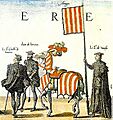Kingdom of Aragon facts for kids
Quick facts for kids
Kingdom of Aragon
|
|||||||||||
|---|---|---|---|---|---|---|---|---|---|---|---|
| 1035–1707 | |||||||||||
 |
|||||||||||
| Status | Kingdom of the Crown of Aragon (since 1162) | ||||||||||
| Capital | |||||||||||
| Common languages | Aragonese, Castilian, Catalan, Latin, Mozarabic, Andalusi Arabic | ||||||||||
| Religion | Roman Catholicism Judaism (minority, until 1492) Islam (minority, until 1526) |
||||||||||
| Government | Feudal monarchy | ||||||||||
| Legislature | Cortes of Aragon | ||||||||||
| Historical era | Medieval / Early Modern | ||||||||||
|
• County of Aragon established as independent kingdom
|
1035 | ||||||||||
|
• Nueva Planta decrees dissolved Aragonese institutions
|
1707 | ||||||||||
|
|||||||||||
| Today part of | Spain | ||||||||||
The Kingdom of Aragon was a powerful kingdom in the Middle Ages and Early Modern period. It was located on the Iberian Peninsula, which is where modern-day Spain is found. Today, the area is known as the Aragon region in Spain.
It's important not to confuse the Kingdom of Aragon with the larger Crown of Aragon. The Crown of Aragon was a group of many different lands ruled by the same king. These lands included the Kingdom of Aragon itself, plus places like Catalonia, Valencia, and Majorca. The king of Aragon ruled all these places, but they were managed separately.
In 1479, the Kingdom of Aragon joined with the Kingdom of Castile. This union was the start of modern Spain. Even after joining, Aragon kept its own special laws and government groups, like the Corts (a type of parliament). This continued until the early 1700s. At that time, new laws called the Nueva Planta decrees changed things. These laws made Spain more centralized, meaning the king had more power over all regions.
Contents
History of Aragon
How Aragon Became a Kingdom
Aragon started as a small county around the city of Jaca. A county is a territory ruled by a count. In the early 800s, it was part of the Carolingian Empire. Later, it became a smaller state under the Kingdom of Pamplona (which later became Navarre). The name Aragon comes from the river Aragón, which flows near Jaca.
In 1035, a king named Sancho III of Navarre died. His kingdom of Navarre was split into three parts. One part, Aragon, went to his son Ramiro. Ramiro became the first real king of Aragon, even though he didn't use that title at first. He fought his brother and made Aragon an independent kingdom.
As Aragon grew, its capital city moved. It started in Jaca. Then, in 1096, it moved to Huesca. Finally, in 1118, it moved to Zaragoza. By 1285, Aragon had taken control of the southern parts of its current region from the Moors (Muslim rulers).
The Crown of Aragon is Formed
In 1150, something very important happened. The Princess of Aragon, Petronilla, married Ramon Berenguer IV, who was the Count of Barcelona. This marriage created a "dynastic union." This means two ruling families joined together. Their son, Alfonso II, inherited all the lands from both his parents.
This union formed the Crown of Aragon. The King of Aragon now also held the title of Count of Barcelona. This meant he ruled not only Aragon but also Catalonia. Over time, the Crown of Aragon grew even bigger. It included the kingdoms of Majorca, Valencia, Sicily, Naples, and Sardinia.
The King of Aragon was the direct ruler of the Aragon region. He also held other titles, like Count of Provence and Duke of Athens. These titles showed his power over different areas.
Joining with Castile to Form Spain
The ruling family of the Crown of Aragon ended in 1410. In 1412, a new king was chosen from Castile, Ferdinand of Antequera. Later, one of his family members, John II, arranged for his son, Ferdinand, to marry Isabella. Isabella was the future queen of Castile.
In 1479, when John II died, the crowns of Aragon and Castile officially joined. This was the beginning of modern Spain. For a long time, Aragon kept its own laws and government. It had its own parliament, called the Corts.
However, this changed after the War of the Spanish Succession. Between 1707 and 1715, King Philip V of Spain issued the Nueva Planta decrees. These laws officially ended the separate kingdoms of Aragon, Valencia, and Majorca, and the Principality of Catalonia. They were merged with Castile to form the Spanish kingdom. A new decree in 1711 gave Aragon back some rights, but its political independence was gone.
The old Kingdom of Aragon continued as an administrative area until 1833. Then, it was divided into three smaller provinces. After the death of Francisco Franco in the late 1900s, Aragon became one of the autonomous communities of Spain in 1982. This means it has its own regional government within Spain today.
Images for kids
-
The location of Aragon within the Crown of Aragon
-
Petronilla of Aragon, and Ramon Berenguer IV, Count of Barcelona depicted later in a 16th-century painting
See also
 In Spanish: Reino de Aragón para niños
In Spanish: Reino de Aragón para niños
- List of Aragonese monarchs
- List of Aragonese royal consorts
- List of Navarrese monarchs
- Counts of Barcelona







